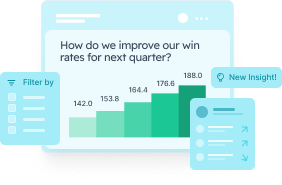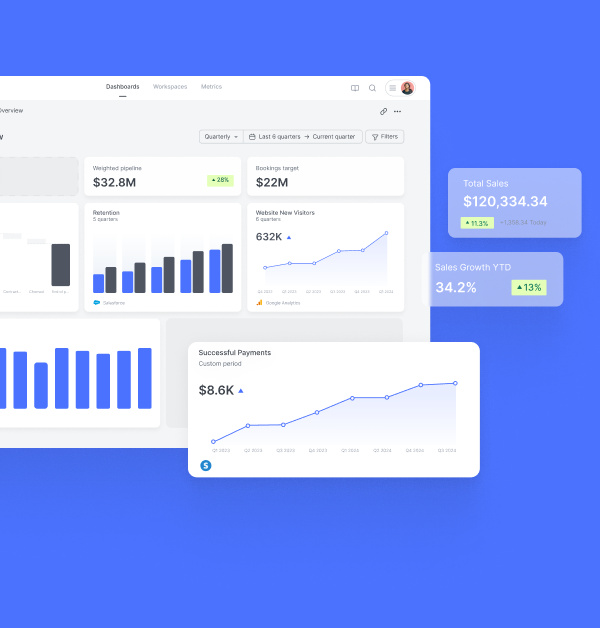- Understanding the Challenges of Marketing Performance Optimization
- Creating a Foundation for Effective Marketing Optimization
- How to Improve Marketing Performance With Data-Driven Decisions
- 6 Ways to Improve Marketing Performance
- Top Tools for Optimizing Your Marketing Programs
- A Team Effort: Marketing Performance Optimization
Mastering Marketing Performance Optimization: A Guide for RevOps Leaders

Co-Founder & CTO
There’s no question that marketing allows businesses to grow, expanding reach beyond the current customer base. However, marketing efforts can be costly, and without consistent marketing performance optimization, the marketing team could be misplacing resources and dollars. In fact, according to a study by Rakuten, about a quarter of marketing budgets are wasted on ineffective channels and advertising.
As a member of the RevOps team, your goal will be helping marketing leaders pinpoint where those marketing dollars can be optimized, providing marketers with the insights they need to make data-informed decisions.

Understanding the Challenges of Marketing Performance Optimization
Marketing teams often struggle to show the true value they bring to a company and the bottom line. As a RevOps leader, it’s important to understand the challenges around marketing performance, which ranges from inconsistent data to tracking across multiple channels.
Tracking performance across channels: Success looks different across each channel, which can make it challenging to know what is working and what’s having the greatest impact. For example, cost per click is a success metric for paid ads while registrants is a measure of success for webinars. Instead of looking at in-platform metrics, it will be important to look at the impact of the activities on the marketing and sales funnels, such as lead creation and marketing qualified leads.
Attribution of marketing tactics: Most leads are part of multiple marketing activation tactics before they convert into a marketing qualified lead, which makes it difficult to accurately attribute marketing activities to sales pipeline or bookings.
Data accessibility: While most SaaS companies have data analytics for marketing, the analytics live within multiple platforms, making it challenging to understand the big picture. Platforms that easily integrate with your existing tools and analyze all revenue data can be helpful in providing a view of revenue flows across the organization.
Creating a Foundation for Effective Marketing Optimization
Before we dig into strategies you can use to improve marketing performance, let’s revisit a few foundational elements that will help set up your marketing program for success.
Know your target market
Without a specific target of companies and people you’d like to purchase products, you’re taking a shot in the dark. Creating an ideal customer profile can help you focus your marketing efforts on the right leads so that you’re not wasting time and resources.
Meet our new Metrics Library!

Understand your most effective channels
Multi-channel marketing is one of the most effective ways to create a cohesive message about your brand, but that doesn’t mean that every channel is right for you. While having a presence on LinkedIn can be incredibly important for a B2B SaaS company, many B2B SaaS companies do not have a Pinterest account because it’s not valuable to their brand.
Evaluate your most and least effective channels to understand where you should be placing your marketing dollars.
Create a source of truth for your data
Marketers have data in many different tools, from Google Analytics to Marketo and Salesforce to name just a few. If you’re not pulling the data together to create a holistic view of how your marketing programs are performing, it can be incredibly challenging to know where to optimize.
Revenue analytics platforms, such as Sightfull, integrate with all of your marketing, sales, finance, and RevOps tools to ensure that you’re getting the big picture across all data sources.
Align your marketing and sales teams
Without consistent communication from the sales and RevOps teams on the quality of leads and how the leads are making it through each stage, marketing teams do not know whether they should be adjusting their strategies. Prioritize cross-team communication and goal setting to create the foundation needed to optimize your programs. 
How to Improve Marketing Performance With Data-Driven Decisions
Effective optimization starts with accurate data, so the first step to optimizing marketing performance is digging into your data across marketing campaigns, channels, and the larger funnel. RevOps teams can guide marketers by asking the following questions and evaluating the metrics below.
What is the cost and ROI of each campaign?
While one campaign may seem to be incredibly effective, it’s always helpful to put the numbers to the test. Knowing how much each campaign costs compared to what the campaign brought in can tell you if those engagement numbers are worth the price tag.
With Sightfull, you can track the reach, contribution, cost and return of each marketing campaign with live and historical data trends. Use templates like Campaign Attribution to help you identify the campaigns that led to the most pipeline and bookings. Go deep into the details to see the most effective touchpoints within those campaigns.
Are leads progressing through the funnel?
Marketing plays a significant role in getting new leads into a SaaS company’s funnel, but not all leads are created equal. By understanding how many leads make it to each stage of the funnel, and where they drop off, gives you key insights into where optimization is needed.
Sightfull allows you to measure how many leads and accounts are created, the duration between key stages (e.g., lead to MQL), and how long it takes new accounts to become a paying customer. Pre-created templates such as Lead Conversion and Lead Generation enable you to track the marketing funnel. You can then share the dashboards you create with marketing teams and execs to increase visibility across the organization.
How does marketing impact the bottom line?
If you can prove that marketing tactics influenced sales pipeline and bookings, then you have a surefire way of knowing their effectiveness.
Using Sightfull, you can gain real-time visibility into how your marketing efforts and activities impact sales performance, deals, pipelines, and bookings. Between Campaign Attribution and MQL Conversion you’ll have a good pulse on how marketing efforts are impacting the bottom line.
Get started optimizing marketing performance today.
6 Ways to Improve Marketing Performance
With the foundation and data needed to guide decision making, marketers can use the following strategies to optimize marketing performance.
1. A/B Test
A/B testing is the practice of comparing two versions of a landing page, web page, or email with slight differences to see what version has a higher conversion rate. Common elements that are tested within A/B tests include headings, subject lines, and CTAs.
Try A/B testing elements of your campaigns to identify what copy, messaging, and CTAs make the biggest impact. Don’t forget to use those learnings in future web copy and emails and share the learnings with the larger team.
2. Segment your leads
From your ideal customer profile, you know who you’re targeting but there are still many differences among your contact base. If you’re sending the same message to all your leads, you’re missing out on the opportunity to create a personalized experience.
There are a number of ways you could segment your leads: cohort, industry, stage within the funnel, or product interest are just a few methods. Use these shared characteristics to build campaigns that are relevant to these specific audiences. For example, if you have two main products, divide your audience into three categories: Product 1, Product 2, and those that show interest in both products. This allows you to deliver content specific to your audience’s interests.
Meet our new Metrics Library!

3. Run a keyword analysis
If you’re looking to increase traffic to your website, consider running a keyword analysis of your website. This will help you identify what keywords you are ranking for within search results, what keywords are slipping, and where there are opportunities to create new content or optimize your website pages.
4. Identify barriers to conversion
What would prevent someone from engaging with your brand and converting? While some barriers to conversion include things that marketers aren’t in control of, such as price or product features, there are a few elements on the marketing side of the house that can hinder conversion.
- A poor mobile experience: With 55.5% of all global web traffic on mobile, a poor mobile experience can deter users from engaging with your brand.
- Too many call-to-actions (CTAs): If there are too many CTAs to choose from, your user doesn’t know where to direct their attention. Streamline your emails and landing pages with a format that guides the user toward one main CTA.
- Overly complex checkout process: How many steps are required for a user to purchase your product or services? This is particularly important for a self-service SaaS product. If there are too many steps or too many form fields required to purchase, the chance that a user abandons their cart increases.
5. Get customer feedback
Ultimately, the best source of truth is your customer. Consider incorporating embedded surveys on your site to capture quick answers to questions, such as “Did you find what you’re looking for?” or “Are you interested in learning more?”
Additionally, user research can also help you better understand your target audience. Consider conducting interviews or sending out more robust surveys to customers to understand what messaging and marketing strategies appeal to them the most.
6. Share learnings internally
Just as important as the optimization of external marketing activities, is the optimization of internal knowledge sharing. As members and teams within your marketing department learn what works and what doesn’t about engaging the right customers, there needs to be a method in place to share these learnings and apply them across the marketing organization.
Top Tools for Optimizing Your Marketing Programs
When considering how to optimize your marketing programs, the following tools can help marketers identify and implement optimizations that increase performance.
- A/B testing tools: To identify what copy, visuals, and messaging is resonating more with your customers, consider a tool such as Optimizely.
- Analytics and tracking tools: Revenue analytics platforms like Sightfull can provide marketers and RevOps teams with in-depth insights on how marketing activities affect revenue across the organization.
- Automation platforms: Marketo and Hubspot marketing can help companies streamline email sending, create automated flows, and build landing pages.
- Content optimization: Tools like Clearscope help marketers optimize blog content with the right keywords so they can more easily rank in search results.
- Customer relationship management (CRM) systems: Salesforce offers systems to help you manage the ins and outs of your customer relationships.
- SEO tools: To understand how your website ranks in Google and how to optimize your pages for SEO, consider using tools like Ahrefs or Semrush.
Get started optimizing marketing performance today.
A Team Effort: Marketing Performance Optimization
The only constant in marketing is change. With new social channels, updates to Google’s algorithm, or new privacy laws, marketing performance optimization is no longer a nice-to-have, but a must-have. Marketers need to continuously optimize their campaigns, tactics, and strategies to ensure they’re making the most of their marketing dollars.
But, they don’t have to do it alone.
“We’ve noticed that GTM teams tend to work in silos with sales, marketing, and customer success all marching toward different goals.
My advice to marketers, and to all teams within the GTM org, is to lean on your RevOps team. They can provide a much clearer picture of the company’s entire revenue flow, and align the teams on joint goals.
It's a game changer. And I'm proud that Sightfull is powering this revolution for our customers, lead by lead, deal by deal.” Sightfull Co-founder & CEO, Noam Liran
Talk to an expert
Learn what optimizing marketing performance means for RevOps leaders
Opportunity Win rate
A must have metric, that calculates the share of all closed deals which were successfully closed won














